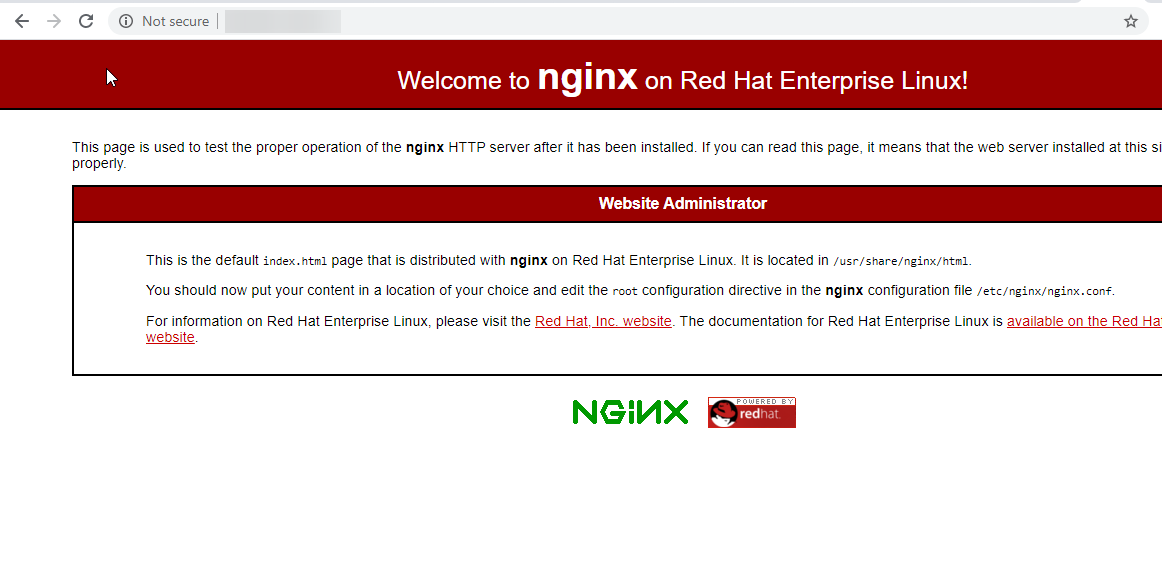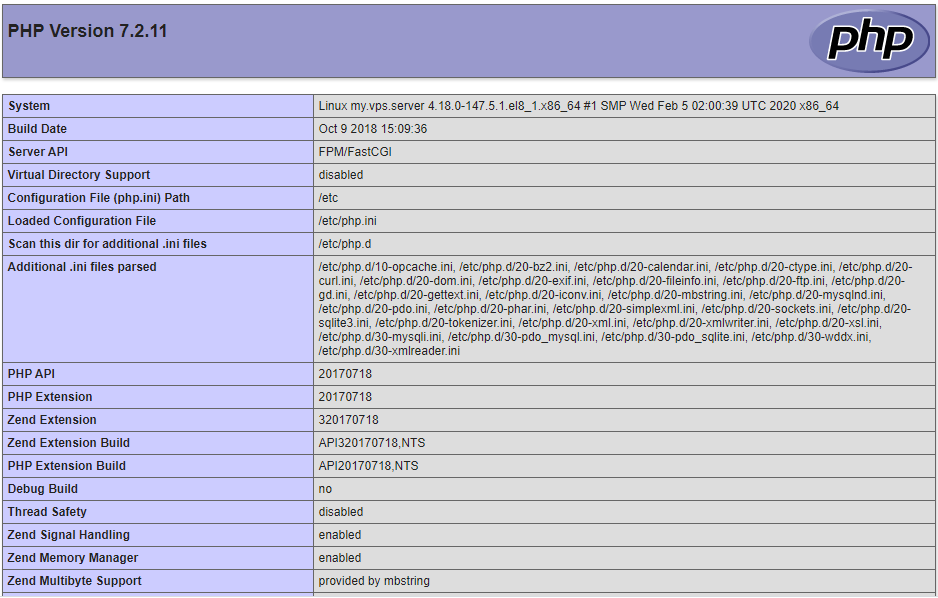How to Install LEMP Stack (Nginx, MariaDB, PHP7.2) on CentOS 8
Install Nginx Web Server on CentOS 8
First, we will start by installing the Nginx web server. To complete the installation, use the following command:
yum install nginx -yOutput:
[root@my ~]# yum install nginx -y
Last metadata expiration check: 0:08:46 ago on Fri 20 Mar 2020 10:33:29 AM EDT.
Dependencies resolved.
================================================================================
Package Arch Version Repo Size
================================================================================
Installing:
nginx x86_64 1:1.14.1-9.module_el8.0.0+184+e34fea82 AppStream 570 k
Installing dependencies:
nginx-all-modules
noarch 1:1.14.1-9.module_el8.0.0+184+e34fea82 AppStream 23 k
nginx-filesystem noarch 1:1.14.1-9.module_el8.0.0+184+e34fea82 AppStream 24 k
nginx-mod-http-image-filter
x86_64 1:1.14.1-9.module_el8.0.0+184+e34fea82 AppStream 35 k
nginx-mod-http-perl
x86_64 1:1.14.1-9.module_el8.0.0+184+e34fea82 AppStream 45 k
nginx-mod-http-xslt-filter
x86_64 1:1.14.1-9.module_el8.0.0+184+e34fea82 AppStream 33 k
nginx-mod-mail x86_64 1:1.14.1-9.module_el8.0.0+184+e34fea82 AppStream 64 k
nginx-mod-stream x86_64 1:1.14.1-9.module_el8.0.0+184+e34fea82 AppStream 85 k
Enabling module streams:
nginx 1.14
Transaction Summary
================================================================================
Install 8 PackagesOnce the installation is complete, enable Nginx (to start automatically upon system boot), start the web server and verify the status using the commands below.
systemctl start nginx
systemctl enable nginx
systemctl status nginxOutput:
[root@my ~]# systemctl start nginx
[root@my ~]# systemctl enable nginx
Created symlink /etc/systemd/system/multi-user.target.wants/nginx.service → /usr/lib/systemd/system/nginx.service.
[root@my ~]# systemctl status nginx
● nginx.service - The nginx HTTP and reverse proxy server
Loaded: loaded (/usr/lib/systemd/system/nginx.service; enabled; vendor prese>
Active: active (running) since Fri 2020-03-20 10:45:12 EDT; 12s ago
Main PID: 32182 (nginx)
Tasks: 3 (limit: 11515)
Memory: 9.5MCheck Nginx version
nginx -vOutput:
[root@my ~]# nginx -v
nginx version: nginx/1.14.1To make your pages available to public, you will have to edit your firewall rules to allow HTTP requests on your web server by using the following commands.
firewall-cmd --permanent --zone=public --add-service=http
firewall-cmd --permanent --zone=public --add-service=https
firewall-cmd --reloadOutput:
[root@server ~]# firewall-cmd --permanent --zone=public --add-service=http
success
[root@server ~]# firewall-cmd --permanent --zone=public --add-service=https
success
[root@server ~]# firewall-cmd --reload
successVerify that the web server is running and accessible by accessing your server’s IP address.
From your browser,
http://IP_address
We need to make user nginx as the owner of web directory. By default it’s owned by the root user.
chown nginx:nginx /usr/share/nginx/html -R Install MariaDB Server
MariaDB is a popular database server. The installation is simple and requires just a few steps as shown.
yum install mariadb-server mariadb -yOutput:
[root@server ~]# yum install mariadb-server mariadb
Last metadata expiration check: 1:28:38 ago on Tue 22 Oct 2019 03:03:52 PM EDT.
Dependencies resolved.
================================================================================
Package Arch Version Repository
Size
================================================================================
Installing:
mariadb x86_64 3:10.3.11-2.module_el8.0.0+35+6f2527ed
AppStream 6.2 M
mariadb-server x86_64 3:10.3.11-2.module_el8.0.0+35+6f2527ed
AppStream 16 M
Installing dependencies:
mariadb-common x86_64 3:10.3.11-2.module_el8.0.0+35+6f2527ed AppStream 62 k
mariadb-connector-c x86_64 3.0.7-1.el8
AppStream 148 kOnce the installation is complete, enable MariaDB (to start automatically upon system boot), start the mariaDB and verify the status using the commands below.
systemctl start mariadb
systemctl enable mariadb
systemctl status mariadbOutput:
[root@server ~]# systemctl enable mariadb
[root@server ~]# systemctl start mariadb
[root@server ~]# systemctl status mariadb
● mariadb.service - MariaDB 10.3 database server
Loaded: loaded (/usr/lib/systemd/system/mariadb.service; enabled; vendor pre>
Active: active (running) since Tue 2019-10-22 16:35:50 EDT; 50s ago
Docs: man:mysqld(8)
https://mariadb.com/kb/en/library/systemd/
Main PID: 2630 (mysqld)Finally, you will want to secure your MariaDB installation by issuing the following command.
mysql_secure_installationOutput:
[root@server ~]# mysql_secure_installation
NOTE: RUNNING ALL PARTS OF THIS SCRIPT IS RECOMMENDED FOR ALL MariaDB
SERVERS IN PRODUCTION USE! PLEASE READ EACH STEP CAREFULLY!
In order to log into MariaDB to secure it, we'll need the current
password for the root user. If you've just installed MariaDB, and
you haven't set the root password yet, the password will be blank,
so you should just press enter here.
Enter current password for root (enter for none):
OK, successfully used password, moving on...
Setting the root password ensures that nobody can log into the MariaDB
root user without the proper authorisation.
Set root password? [Y/n] y
New password:
Re-enter new password:
Password updated successfully!
Reloading privilege tables..
... Success!Once secured, you can connect to MySQL and review the existing databases on your database server by using the following command.
mysql -e "SHOW DATABASES;" -pOutput:
[root@server ~]# mysql -e "SHOW DATABASES;" -p
Enter password:
+--------------------+
| Database |
+--------------------+
| information_schema |
| mysql |
| performance_schema |
+--------------------+
[root@server ~]# Install PHP
To Install PHP-FPM on CentOS 8
yum install php php-mysqlnd php-fpm php-opcache php-gd php-xml php-mbstring -yOutput:
[root@my ~]# yum install php php-mysqlnd php-fpm php-opcache php-gd php-xml php-mbstring -y
Last metadata expiration check: 0:07:44 ago on Fri 20 Mar 2020 10:59:28 AM EDT.
Dependencies resolved.
================================================================================
Package Arch Version Repo Size
================================================================================
Installing:
php x86_64 7.2.11-2.module_el8.1.0+209+03b9a8ff AppStream 1.5 M
php-fpm x86_64 7.2.11-2.module_el8.1.0+209+03b9a8ff AppStream 1.6 M
php-gd x86_64 7.2.11-2.module_el8.1.0+209+03b9a8ff AppStream 84 k
php-mbstring x86_64 7.2.11-2.module_el8.1.0+209+03b9a8ff AppStream 581 k
php-mysqlnd x86_64 7.2.11-2.module_el8.1.0+209+03b9a8ff AppStream 190 k
php-opcache x86_64 7.2.11-2.module_el8.1.0+209+03b9a8ff AppStream 230 k
php-xml x86_64 7.2.11-2.module_el8.1.0+209+03b9a8ff AppStream 189 k
Installing dependencies:
apr x86_64 1.6.3-9.el8 AppStream 125 k
apr-util x86_64 1.6.1-6.el8 AppStream 105 k
centos-logos-httpd
noarch 80.5-2.el8 AppStream 24 k
httpd x86_64 2.4.37-16.module_el8.1.0+256+ae790463 AppStream 1.7 M
httpd-filesystem noarch 2.4.37-16.module_el8.1.0+256+ae790463 AppStream 35 k
httpd-tools x86_64 2.4.37-16.module_el8.1.0+256+ae790463 AppStream 103 k
mod_http2 x86_64 1.11.3-3.module_el8.1.0+213+acce2796 AppStream 158 k
php-cli x86_64 7.2.11-2.module_el8.1.0+209+03b9a8ff AppStream 3.1 M
php-common x86_64 7.2.11-2.module_el8.1.0+209+03b9a8ff AppStream 655 k
php-pdo x86_64 7.2.11-2.module_el8.1.0+209+03b9a8ff AppStream 122 k
Installing weak dependencies:
apr-util-bdb x86_64 1.6.1-6.el8 AppStream 25 k
apr-util-openssl x86_64 1.6.1-6.el8 AppStream 27 k
Enabling module streams:
httpd 2.4
php 7.2
Transaction Summary
================================================================================
Install 19 PackagesOnce the installation is complete, enable php-fpm (to start automatically upon system boot), start the php-fpm and verify the status using the commands below.
systemctl start php-fpm
systemctl enable php-fpm
systemctl status php-fpmOutput:
[root@my ~]# systemctl start php-fpm
[root@my ~]# systemctl enable php-fpm
Created symlink /etc/systemd/system/multi-user.target.wants/php-fpm.service → /usr/lib/systemd/system/php-fpm.service.
[root@my ~]# systemctl status php-fpm
● php-fpm.service - The PHP FastCGI Process Manager
Loaded: loaded (/usr/lib/systemd/system/php-fpm.service; enabled; vendor pre>By default, PHP-FPM runs as the apache user. Since we are using Nginx web server, we need to change following line.
vi /etc/php-fpm.d/www.conf
user = apache
group = apacheChange them to
user = nginx
group = nginxOnce changed, need to reload php-fpm
systemctl reload php-fpmTest your PHP, by creating a simple info.php file with a phinfo() in it. The file should be placed in the directory root for your web server, which is /usr/share/nginx/html/info.php.
To create the file use:
echo "<?php phpinfo() ?>" > /usr/share/nginx/html/info.phpRestart the Nginx and PHP-FPM.
systemctl restart nginx php-fpmNow again, access http://localhost/info.php or http://yourserver-ip-address/info.php. You should see a page similar to below one.

Done!
CrownCloud - Get a SSD powered KVM VPS at $4.5/month!
Use the code WELCOME for 10% off!
1 GB RAM / 25 GB SSD / 1 CPU Core / 1 TB Bandwidth per month
Available Locations: LAX | MIA | ATL | FRA | AMS